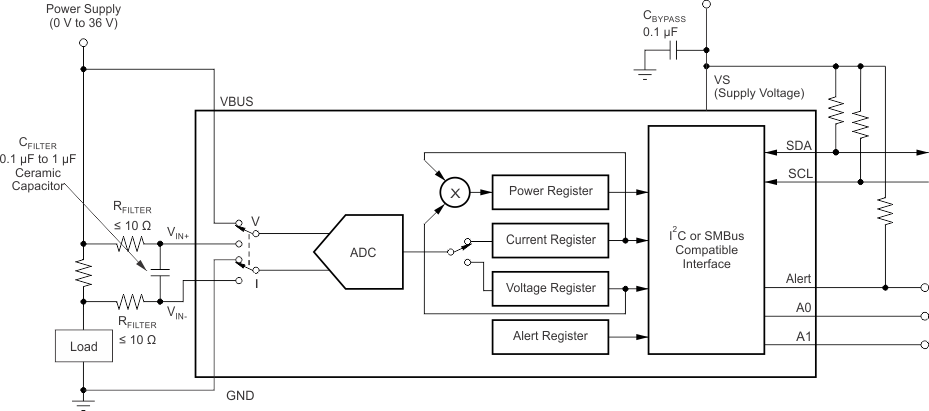SBOS601A February 2012 – December 2021 INA230
PRODUCTION DATA
- 1 Features
- 2 Applications
- 3 Description
- 4 Revision History
- 5 Related Products
- 6 Pin Configuration and Functions
- 7 Specifications
-
8 Detailed Description
- 8.1 Overview
- 8.2 Functional Block Diagram
- 8.3 Feature Description
- 8.4 Device Functional Modes
- 8.5 Programming
- 8.6
Register Maps
- 8.6.1 Configuration Register (00h, Read/Write)
- 8.6.2 AVG Bit Settings [11:9]
- 8.6.3 VBUS CT Bit Settings [8:6]
- 8.6.4 VSH CT Bit Settings [5:3]
- 8.6.5 Mode Settings [2:0]
- 8.6.6
Data Output Register
- 8.6.6.1 Shunt Voltage Register (01h, Read-Only)
- 8.6.6.2 Bus Voltage Register (02h, Read-Only) (1)
- 8.6.6.3 Power Register (03h, Read-Only)
- 8.6.6.4 Current Register (04h, Read-Only)
- 8.6.6.5 Calibration Register (05h, Read/Write)
- 8.6.6.6 Mask/Enable Register (06h, Read/Write)
- 8.6.6.7 Alert Limit Register (07h, Read/Write)
- 9 Application and Implementation
- 10Power Supply Recommendations
- 11Layout
- 12Device and Documentation Support
- 13Mechanical, Packaging, and Orderable Information
Package Options
Refer to the PDF data sheet for device specific package drawings
Mechanical Data (Package|Pins)
- RGT|16
- DGS|10
Thermal pad, mechanical data (Package|Pins)
- RGT|16
Orderable Information
8.4.2 Filtering and Input Considerations
Measuring current is often noisy, and such noise can be difficult to define. The INA230 device offers several options for filtering by allowing the conversion times and number of averages to be selected independently in the Configuration register (00h). The conversion times can be set independently for the shunt voltage and bus voltage measurements to allow added flexibility in configuring the monitoring of the power-supply bus.
The internal ADC is based on a delta-sigma (ΔΣ) front-end with a 500 kHz (±30%) typical sampling rate. This architecture has good inherent noise rejection; however, transients that occur at or very close to the sampling rate harmonics can cause problems. Because these signals are at 1 MHz and higher, they can be managed by incorporating filtering at the input of the device. The high frequency enables the use of low-value series resistors on the filter with negligible effects on measurement accuracy. In general, filtering the device input is only necessary if there are transients at exact harmonics of the 500 kHz (±30%) sampling rate (greater than 1 MHz). Filter using the lowest possible series resistance (typically 10 Ω or less) and a ceramic capacitor. Recommended values for this capacitor are between 0.1 μF and 1 μF. Figure 8-3 shows the device with a filter added at the input.
Overload conditions are another consideration for the device inputs. The device inputs are specified to tolerate 40 V across the inputs. A large differential scenario might be a short to ground on the load side of the shunt. This type of event can result in full power-supply voltage across the shunt (as long the power supply or energy storage capacitors support it). Removing a short to ground can result in inductive kickbacks that could exceed the 40-V differential and common-mode rating of the device. Inductive kickback voltages are best controlled by Zener-type transient-absorbing devices (commonly called transzorbs) combined with sufficient energy storage capacitance. See the TI Design Transient Robustness for Current Shunt Monitors (TIDU473) which describes a high-side current shunt monitor used to measure the voltage developed across a current-sensing resistor when current passes through it.
In applications that do not have large energy storage electrolytics on one or both sides of the shunt, an input overstress condition may result from an excessive dV/dt of the voltage applied to the input. A hard physical short is the most likely cause of this event, particularly in applications with no large electrolytics present. This problem occurs because an excessive dV/dt can activate the ESD protection in the device in systems where large currents are available. Testing demonstrates that the addition of 10-Ω resistors in series with each input of the device sufficiently protects the inputs against this dV/dt failure up to the 40-V rating of the device. Selecting these resistors in the range noted has minimal effect on accuracy.
 Figure 8-3 Input Filtering
Figure 8-3 Input Filtering